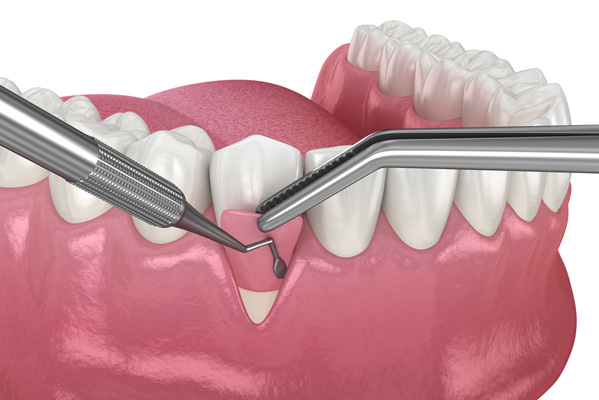Soft Tissue GraftingThe Woodlands, TX
Soft tissue grafting is a procedure that addresses excessive gingival recession by replacing the lost soft gum tissue. It does so by using healthy gum tissue to rebuild the receded gums. Soft tissue grafting can enhance the smile and stop the adverse side effects of gum recession.
Soft tissue grafting is available at Montgomery County Periodontal Associates in The Woodlands and the surrounding area. Take immediate action to stop any additional gum recession and bone loss today. Call us at 281-404-7548 to schedule an appointment or learn more about our services.
Reasons for Soft Tissue Grafting
It is impossible to understand soft tissue grafting without first understanding gum recession. Patients that suffer from gum recession have teeth that pull away, exposing the tooth or the tooth's root. This exposure leaves the bone without a protective barrier and, thus, susceptible to damage. Though many American adults suffer from gum recession, it is not uncommon for it to go unnoticed until it has already progressed.
The most obvious sign of gum recession is aesthetic: a noticeably gummier smile. Still, gum recession is not just a cosmetic issue. Rather, exposed tooth roots can gradually cause tooth sensitivity or even tooth loss. Soft tissue grafting can correct and stop the effects of gum recession.
Check out what others are saying about our Soft Tissue Grafting services on Yelp: Soft Tissue Grafting The Woodlands
Types of Soft Tissue Grafting
There are three main types of soft tissue grafts: connective tissue grafts, free gingival grafts, and pedicle grafts. Free gingival grafts and connective tissue grafts take tissue from other areas of the mouth, while pedicle grafts take tissue from around the affected area. In a pedicle graft, the graft tissue is pulled down over the targeted area. This type of graft also involves removing a small portion of tissue from the roof of the mouth and stitching it to the targeted area. Patients should be aware that this type of graft is usually only recommended for patients with an adequate amount of gum tissue in the targeted areas.
After Dr. Mason has removed a small portion of tissue from the roof of the mouth in a free gingival graft, he will then stitch it to the targeted area. These types of gum grafts are typically recommended for patients with thin gums and who need extra tissue to prevent further gum recession. Connective tissue grafts are the most common type of soft tissue graft. These involve removing a portion of connective tissue underneath the top layer through a small flap in the roof of the mouth. Dr. Mason then covers the receded gums by stitching the tissue graft next to the targeted area.
Recovering from Soft Tissue Grafting
Soft tissue grafting is an outpatient procedure, meaning patients can leave the office soon after completing the surgery. Some patients may need to wait an hour or two before leaving to allow our team to observe them for any signs of complications. Though the procedure is generally safe when performed by a trained professional, no procedure is without risks. When complications do occur with gum grafting, they tend to be minimal.
Potential complications include bleeding, swelling, teeth sensitivity, spaces appearing between the teeth, infection, and teeth feeling looser. Most patients find they can return to work and day-to-day activities the day after, and any pain they experience lasts only a few days. Furthermore, any discomfort is easily managed with over-the-counter medications. However, each patient's personal tolerance level for pain and discomfort is different.
For most patients, it only takes about a week or two for the mouth to heal fully. However, it is not uncommon for it to take longer. Some patients will require a follow-up appointment to check up on the healing process and remove any stitches as necessary. Patients should not be concerned if gums look slightly different and feel a little tighter and firmer after surgery. However, any signs of infection should be taken very seriously, and patients should call us right away if they experience (1) persistent bleeding, even after applying pressure, (2) fever and pus, and (3) unexpected bruising, pain, and swelling.
Call Us Today
Soft tissue grafting can correct a gummy smile and prevent any further damage from gum recession. We at Montgomery County Periodontal Associates may be able to help. Call us today at 281-404-7548 to schedule an appointment or learn more about our services.
Frequently Asked Questions
Why are gums important?
Gums, also known as the gingivae, are the pink tissue attached to the teeth in the back of the mouth. They are rich in blood vessels beneath the mucous membrane, heavy, and attached to both sets of teeth. Gums must be intact and attached to the jawbone to cover and protect the tooth roots.
What are the symptoms of gum recession?
Many times, patients do not realize that their gums are receding until it affects their smiles. This can mean their teeth look longer or they have increased space between the teeth. This may cause some patients to fear that they are losing their teeth altogether. The exposed tooth roots may also cause patients to experience sensitivity to heat and cold.
What are the risk factors for gum recession?
Gum disease is the number one cause of gum recession. However, other risk factors include certain medications, genetic predisposition, old age, high levels of stress, a habit of bruxism, and tobacco use. Patients with systemic diseases, such as obesity, may also be at increased risk.
Can I be under anesthesia for my soft tissue grafting surgery?
Yes. All three types of soft tissue grafting procedures can incorporate general anesthesia, which leaves patients unconscious throughout the procedure. Make sure to let us know well in advance if you are interested in sedation dentistry so we can determine what the best course of action is for you.
How long will the effects of soft tissue grafting last?
Soft tissue grafting repairs existing damage of gum recession, but it cannot guarantee against further gum damage that you may incur in the future. As such, it is critical that you remain vigilant in maintaining good oral hygiene and keeping regular dental checkups even after your procedure. If you do so, it is possible for the effects of gum grafting to last a lifetime.
Does dental insurance cover soft tissue grafting?
The best way to know is to ask your insurer directly. Many patients are able to get part or all of their gum grafting surgery costs paid for by their provider. However, this varies on a case-by-case basis.
Contact Us
Montgomery County Periodontal Associates is located at 1001 Medical Plaza Dr Ste 110 The Woodlands, TX 77380.





